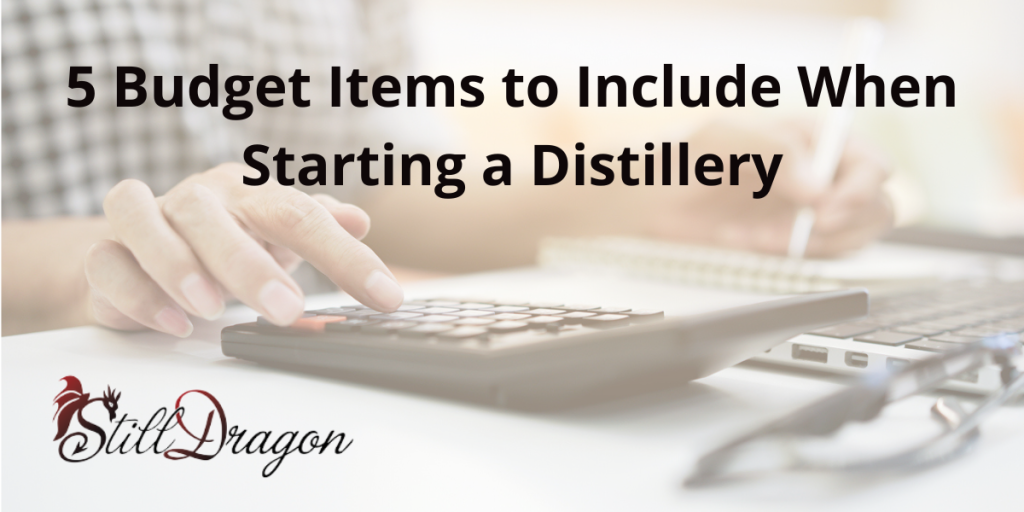5 Budget Items to Include When Starting a Distillery

Have you noticed a new vodka brand every time you go to the liquor store? Or maybe seen the ever-increasing brands of hard seltzers in the beer aisle? There is no doubt that the Craft Beverage movement is in full swing, and there is no end in sight. According to the American Craft Spirits Association, the Craft Spirits market share grew by 4.7%, and in 2021 there were 2,290 distilled spirits producers in the US, and only expected to continue to grow. Of course, that is going to leave whiskey lovers and entrepreneurs wondering how to break into the industry. It may not be overly difficult to start distilling, but it can be a costly investment – especially if you don’t have a good business plan.
How to Start A Distillery
Chances are, if you want to open a distillery, you already know the science behind distilling. You’ve already fallen in love with a spirit that you want to create; now, you need a plan to create that spirit. Start with your end goal – how much you want to produce and how many hours a day you want to work to accomplish that goal. This will help you decide the size of the equipment you will need and the extra equipment you will need to hold raw materials.
Once you’ve got your equipment figured out, you should have your minimum cost of starting a distillery, you will also have a starting footprint for your building. You will need a building that can house the equipment you need, plus some square footage for storage areas and a tasting room, don’t forget to include some square footage for office space as well. Be sure to check your local laws to see if you can sell cocktails out of your tasting room – if you can, finding a building with good foot traffic is beneficial.
Once you’ve got the cost of a building that will sufficiently house your equipment and tasting room, you are ready to start building the rest of your distillery budget.
Cost of Starting a Distillery
The costs associated with starting a distillery will add up quickly, and on things, you wouldn’t even think you’ve needed. Of course, there are grains and yeast, bottles and tops that you’ve factored into the cost of making your product, but have you thought about how you’re going to move everything around the distillery? How are you going to get your product in front of people? How are you going to keep a record for the TTB? And who is going to sell your product?
There are 5 line items on your budget that can quickly increase your budget, but they are necessary for day-to-day operations:
- Forklift – Possibly one of the most important pieces of equipment to have. You will need the forklift from the day you receive your equipment and every day after. Whether it’s getting equipment off the delivery truck, moving equipment around your distillery, or lifting totes/super sacks, barrels, and/or pallets of finished goods- a forklift is key. Don’t forget a good maintenance routine budget for the forklift, this will help prevent forklift downtime when you need it.
- Extra Parts – Having a few spare parts such as gaskets, clamps, and sight glasses may seem unnecessary until you’re in the middle of production and suddenly need that part.
- Marketing Budget – Do not skimp on a marketing budget! Being able to get your product out into the world through marketing and advertising is necessary. Hiring a marketing person or a marketing company will be the backbone of getting your customers in the door. The marketing budget should be one of the larger numbers in your business plan.
- Computer Software – Work smart, not hard. Do your research and find a good software program that will help you track your production outputs to align with TTB requirements. Some of the software programs offer reports for accounting purposes, as well as reports to give to the TTB. This could save you hundreds of man hours in the long run.
- Employees – If you want a great product and sales, find yourself a good team to work with- and this probably won’t come cheap. There is nothing worse than losing revenue because your employees are careless with your equipment or products or rude to your customers. Find employees that you would trust running your business in the event that you couldn’t be there.
Once you’ve got the finances allocated properly and the right people in the right places, you will be well on your way to starting your distillery that can be profitable.
Starting a distillery can be stressful and time-consuming, especially as you add up the costs to get your product to market. Take it slow; running a profitable distillery is a marathon, not a sprint. If you have any questions, give us a call, and we will be happy to answer any questions you might have.
Most importantly, when it’s all said and done, you will be able to sit back and sip on the fruits of your labor.